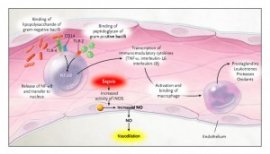Nursing Care Plan for Sepsis
 The patients with highest risk from the septic shock and bacteremia would include infants, elderly and people who are immune-suppressed with chronic diseases. The long term goals of nursing diagnosis for sepsis are the maintenance of negative cultures by following the antibiotic therapy. The temperature must be maintained below 100 degree of Fahrenheit, the heart rate has to be in between 60 to 100 beats per minutes and the MAP should be higher than 70 mmHq.
The patients with highest risk from the septic shock and bacteremia would include infants, elderly and people who are immune-suppressed with chronic diseases. The long term goals of nursing diagnosis for sepsis are the maintenance of negative cultures by following the antibiotic therapy. The temperature must be maintained below 100 degree of Fahrenheit, the heart rate has to be in between 60 to 100 beats per minutes and the MAP should be higher than 70 mmHq.
DEFINITION SIGNS AND SYMPTOMS OF SEVERE SEPTIC SHOCK
Sepsis is the body’s response to infection. The body triggers a series of events causing an inflammatory syndrome more or less generalized responsible for hemodynamic and micro circulatory.
There are 3 kinds of sepsis: the 3 phases of successive worsening of the infection and the inflammatory response:
Sepsis: Presence of infection clinically and / or micro-biologically documented SIRS = systemic inflammatory response syndrome (presence of at least two of these signs): fever> 38.3 ° or 90 beats / min tachypnea with EN> 20/mn or PaCO2 12, 000 or 10% immature forms. severe sepsis:-
Onset sepsis and organ dysfunction and / or hypotension corrected by volume and / or lactate> 4 mmol / l
-
Hypotension secondary to sepsis not only corrected by volume expansion.
Early detection of severe sepsis in reception area
Early recognition of severe sepsis is crucial because earliness of hemodynamic management determines the prognosis.
Immediately detectable signs in reception area and orientation:
-
chills without fever.
oliguria.
decreased level of consciousness, confusion.
tachypnea> 30.
mottled extremities, joints.
cold extremities and cyanic.
increased pulse rate> 90 beats / min.
Systolic BP 20mg / l or more than 50% of the base figure), increased urea and oliguria.
hepatic failure with increased ALT, AST, GGT, bilirubin> 30mmol / l.
hypoxia.
metabolic acidosis results of blood gas.
signs of DIC.
encephalopathy or delirium with a Glasgow
 Tuberculosis, MTB, or TB (short for tubercle bacillus) is a common, and in many cases lethal, infectious disease caused by various strains of mycobacteria, usually Mycobacterium tuberculosis. Tuberculosis typically attacks the lungs but can also affect other parts of the body. It is spread through the air when people who have an active TB...
Tuberculosis, MTB, or TB (short for tubercle bacillus) is a common, and in many cases lethal, infectious disease caused by various strains of mycobacteria, usually Mycobacterium tuberculosis. Tuberculosis typically attacks the lungs but can also affect other parts of the body. It is spread through the air when people who have an active TB...

